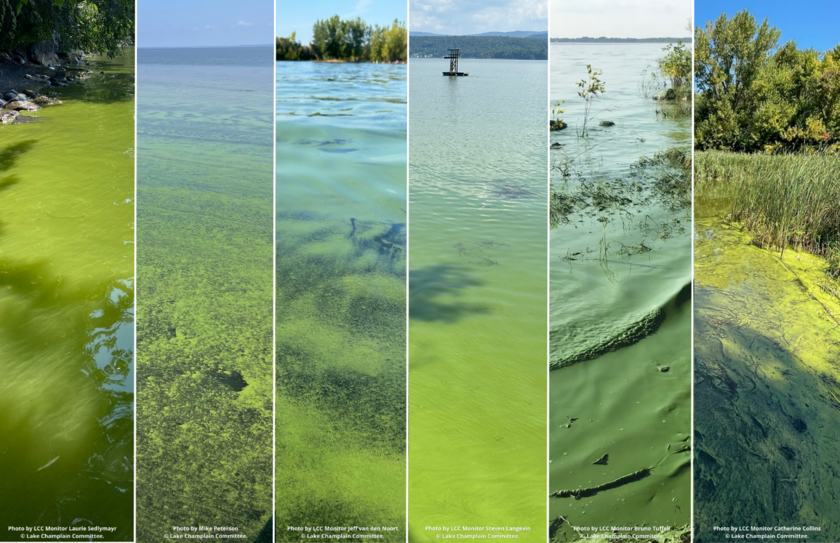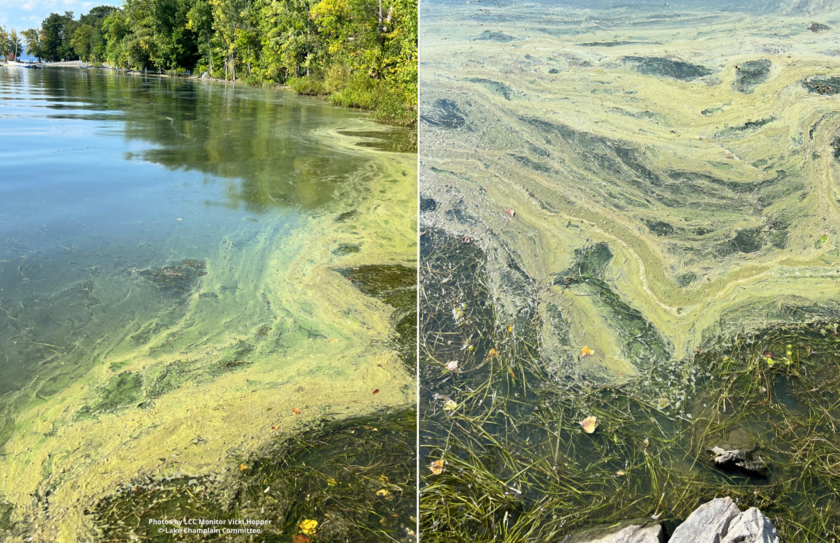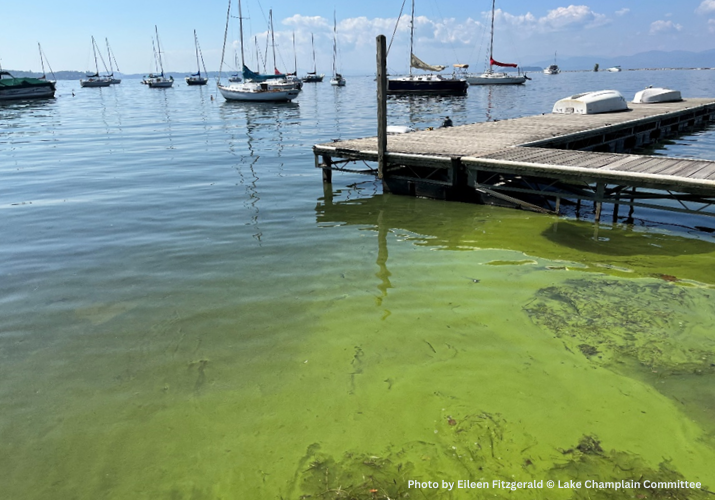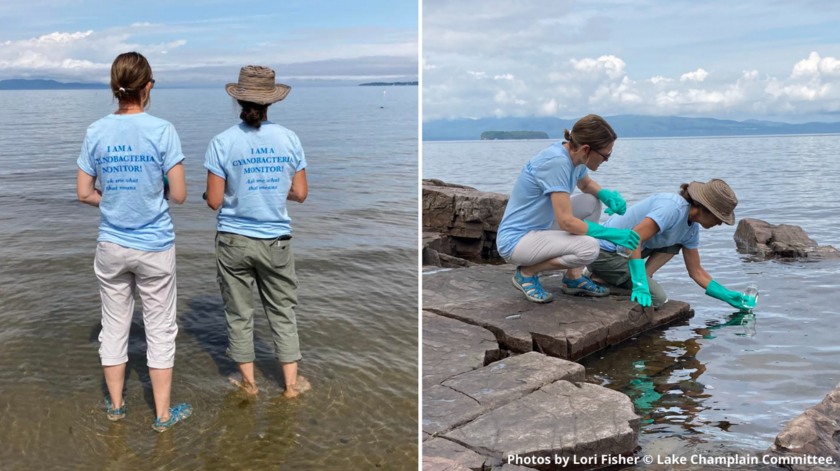Lake Look: In Full (Cyanobacteria) Bloom
JUNE 2023

Summer breathes life into the Champlain Valley—trees leaf, insects hum, and birds come back to their summer homes. Among this annual reawakening of ecological activity is cyanobacteria. With longer and sunnier days warming the lake, conditions can become a breeding ground for blooms of cyanobacteria (sometimes called blue green algae, even though they are not technically algae) that can inundate water and close beaches.

Drivers of Cyanobacteria Blooms
Bloom-causing factors include nutrients (both phosphorus and nitrogen), temperature, and weather. All organisms need phosphorus to grow and cyanobacteria are no exception. Excess nutrients—particularly phosphorus--from agricultural and stormwater runoff, as well as wastewater from accidental discharges and combined sewer overflows, create fodder for cyanobacteria.
When nutrients wash off land and flush into the waters they help feed their growth. Both current day practices and historical contributions of phosphorus bound up in lake sediments influence cyanobacteria growth and abundance. The places on Lake Champlain where blooms tend to last the longest and are the scummiest are often locations where there’s already a high nutrient level.
Temperature is another important factor. With climate change we are seeing rising temperatures -- shorter winters, more intense heat waves. The water is warming up faster and sooner, frosts dates are coming later and blooms are sticking around later and starting earlier. The greater frequency and intensity of storm events bring more nutrients to our waterways.
Calm weather can help influence bloom formation and duration. Some cyanobacteria have gas vacuoles. On a calm day they can regulate their buoyancy and are more likely to be able to move up in the water column and set up for a bloom.
Controlling blooms
The best way to control cyanobacteria is to stop feeding it with nutrients. On a large scale, that can take several forms. Adopting agricultural practices that reduce fertilizer runoff, implementing stormwater reduction measures, and updating/maintaining wastewater facilities is key. Legislation that LCC championed over the years to ban phosphates from laundry and dishwasher detergents and lawn fertilizers, reduce nutrient loading from agriculture, require stormwater management, and upgrade and maintain wastewater treatment facilities are also important victories in the fight to reduce phosphorus. These are all critical big picture measures to prevent cyanobacteria blooms, but as an individual, there are additional ways you can help reduce nutrient input to the lake: cleaning storm drains; preventing leaves and grass clippings from entering waterways; maintaining or planting native trees and shrubs around shorelines and streams to reduce erosion; properly maintaining septic systems; and adopting any of the practices described on Rethink Runoff’s website.
While reducing nutrient inputs can prevent larger and more long-lasting cyanobacteria blooms from occurring, warming waters from climate change and “legacy phosphorus”, or surplus phosphorus that has built up and lingered over the course of decades, comprise a reality of continuing blooms. With cyanobacteria blooms as a fact of life in the lake for the time being, it’s important to learn to recognize, avoid, and report them.

How can you recognize cyanobacteria?
Detecting cyanobacteria is like learning a new instrument or sport—it takes practice. Explore the cyanobacteria section of LCC’s website for a host of resources that will help you identify cyanobacteria. Attend an informational session to learn more or get trained to become a cyanobacteria monitor and help us gather information about water conditions on Lake Champlain and inland lakes. Subscribe to LCC’s weekly water quality reports: https://www.lakechamplaincommittee.org/lcc-at-work/cyanobacteria-in-lake/cyanobacteria-weekly-report-subscription. During the monitoring season you’ll receive weekly emails about conditions reported during the previous week along with photographs and information to help you learn how to recognize cyanobacteria and differentiate it from other phenomena like duckweed and filamentous green algae which don’t produce cyanotoxins.
When cyanobacteria first become visible in the water they often show up as small, rounded or fuzzy green specks or dots in the water. Cyanobacteria can multiply quickly and as more come together they can form blooms on or below the water surface. At the bloom stage, cyanobacteria may resemble pea soup. In areas with high density of cyanobacteria, or where the cyanobacteria have washed ashore, there may be a paint-like sheen in hues of green, blue or turquoise, but they can also present as red, purple, brown, or white.

Health concerns
Aside from coloring the water and creating surface scums, why are cyanobacteria blooms a concern? From an ecological standpoint, when blooms become thick they block out sunlight that aquatic plants and animals need to survive. From a human health standpoint, cyanobacteria can produce cyanotoxins. There is no way to discern if a cyanobacteria bloom is releasing cyanotoxins without a laboratory test. Health effects of cyanotoxin exposure can range from a mild rash, gastrointestinal issues, and eye, nose, and throat irritations in the case of short-term acute exposure; to liver and neurological damage in cases of long-term exposure or significant ingestion of water. Children and dogs are most vulnerable to cyanotoxins because of a higher likelihood of drinking water during a bloom, their smaller body size, and their inability to read warning signs. Dogs can receive a larger dose of toxins because they often drink lake water, swim with their mouths open, and then lick their fur after coming out of water.
Report conditions
Once you recognize the cyanobacteria, don’t touch it or get too close to it without personal protective gear. Photograph your sighting and file a report through the Lake Champlain Committee’s online form. We’ll review your information and add it to the Cyanobacteria Data Tracker housed on the Vermont Department of Health website. The tracker is a collaborative effort of Vermont health and environmental agencies and the Lake Champlain Committee. It’s accessible to anyone with an internet connection and includes results from the latest monitoring at over 100 Lake Champlain sites and more than 50 inland lake locations. Users can check for recent reports by lake region or town, click on a site for alert status for more information and pictures of conditions witnessed.

LCC Cyanobacteria Monitoring Program
It is important to gather as much data on cyanobacteria blooms as possible to actively inform lake-users about recent water conditions, sign public access areas to keep people safe, and understand cyanobacteria trends over time. To aid in this effort, LCC developed a cyanobacteria monitoring program. Now in its twentieth year, we annually train over 100 volunteers as community science monitors to assess and report conditions at hundreds of Lake Champlain and inland lake locations. Monitors visit their sites on at least a weekly basis during the monitoring season which runs from late June through early November and file an online report on the presence or absence of cyanobacteria. If blooms are observed they report daily through the time blooms dissipate whenever possible. During the 2022 season, LCC monitors and state and municipal partners made nearly 3,000 reports. Anyone with an hour of free time each week can be an LCC cyanobacteria monitor—fill out our cyanobacteria monitoring interest form or contact us through lcc@lakechamplaincommittee.org.
We hope everyone has the chance to connect with the lake as summer unfolds, and stays safe and informed on cyanobacteria conditions!
Lake Look is a monthly natural history column produced by the Lake Champlain Committee (LCC). Formed in 1963, LCC is a bi-state nonprofit that uses science-based advocacy, education, and collaborative action to protect and restore water quality, safeguard natural habitats, foster stewardship, and ensure recreational access. You can join, renew your membership, make a special donation, or volunteer to further our work.
